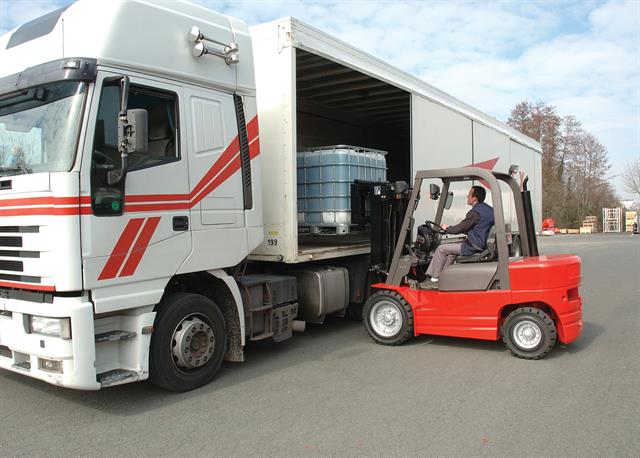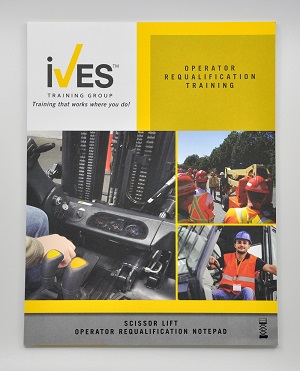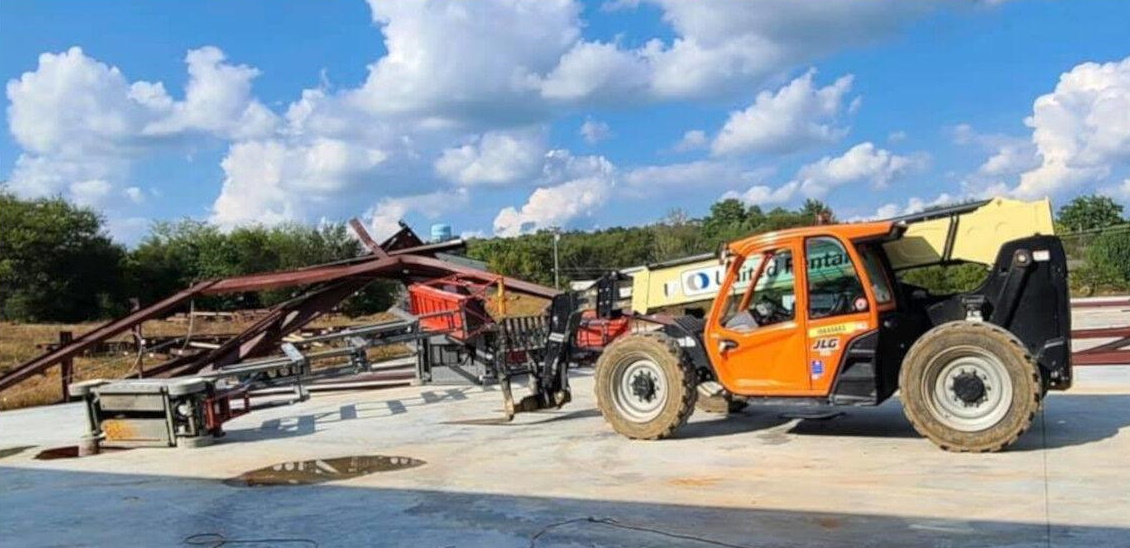Three Steps For Keeping Forklift Drivers Safe.

The risk of accidents and serious injuries increases dramatically whenever forklifts and pedestrians work in the same space, so the arrival of delivery drivers into busy loading areas needs careful management.
Here we have outlined some simple steps you can take to avoid common hazards during loading operations.
1. Keep a safe distance
It is no surprise that delivery drivers often want to help when their vehicles are being loaded - after all, it is their responsibility to ensure the security of their load and they may have a preferred order for unloading at the other end.
However, while they can specify their requirements, they should not be allowed in the loading area and must remain in a safe position while the forklift is in operation. Trying to help the process along either by holding back a curtain, steadying a load or directing from alongside puts them in real danger should a load be lost or the operator lose sight of them. And the serious injuries caused are almost always avoidable, because the pedestrian should never be in the operating area in the first place.
In recent years, one UK company was fined GBP1.2 million (USD1.65 million) after a HGV driver was fatally crushed when an overloaded forklift truck overturned. The resulting investigation found that the forklift had been unloading a 2.2 T load (42% over its maximum operational capacity), causing the truck to tip. It also found that there was no procedure in place to keep pedestrians a safe distance from loading/unloading operations.
Such segregation measures are vital because a safe distance will ensure waiting drivers are not injured, should there be unsafe operating methods.
Safety step: Ensure you have adequate segregation measures to keep delivery drivers and other pedestrians a safe distance away from forklifts.
Physical measures such as barriers as well as pedestrian areas and walkways can be used to help the relevant parties to remain in a safe space.
Of course, you should never find delivery drivers in unsafe positions if there are relevant safety policies in place that are communicated and followed, which brings us to our next step.
2. Implement a clear Safe System of Work
Producing risk assessments and the resulting Safe Systems of Work (SSOW) plays a crucial role in ensuring that all hazards associated with tasks such as loading and unloading are eliminated or the risks sufficiently minimized.
Though SSOW can significantly reduce the number of accidents on site, all too often, companies do not have these in place.
In another recent incident, a UK manufacturer was fined GBP38,000 (USD50,000) when an HGV driver was seriously injured during unloading, after being trapped between a falling load and his own vehicle.
The HSE found that there was no SSOW for unloading or loading and no rules for visiting drivers on where to wait.
Safety step: Establish and share your SSOW, then ensure that management continually enforces them (this follow up is crucial to effectively reducing risk).
Make sure that delivery drivers are fully briefed to follow any parts that apply to them. This could include:
- A designated waiting area for drivers, away from the loading area, or other specified safe locations e.g. in the cab with the engine off.
- A key control system where drivers hand over their vehicle keys until loading is complete (to limit the temptation to return to the vehicle during loading).
SSOW are a vital tool to keep sites safe, but are only effective if they are followed.
Companies' good intentions can often be thwarted if you don't complete the final step.
3. Communicate safety to everyone on site
Sometimes, SSOW may be in place but either they are not followed or not conveyed to everyone who could be affected - including visiting drivers.
This undermines any good work done to reduce risk for those involved in the task.
As an additional measure, methods such as 'Show Your Hand' can be used to standardize communication between forklift operators and those around them on foot.
Operators can use this to alert delivery drivers or other pedestrians if they are coming too close to the truck, and signal to them that they must stop, as follows:
Step 1. If a pedestrian is coming too close, stop the truck.
Step 2. 'Show your hand' to signal them to stop.
Step 3. If they do not stop, turn off the ignition to reduce the risk.
Safety step: Managers have a responsibility to communicate SSOW to everyone who could be affected, including any visiting personnel, so that safety procedures can be adhered to (e.g. via briefings, training, safety meetings, signage, regular monitoring).
Many accidents and injuries can be avoided if we understand the risks and how to avoid them.
Keeping everyone informed and providing the relevant training for operators and pedestrians alike will help all those who work on or around forklift trucks to stay safe.
Those overseeing operations also have a vital role to play in monitoring and enforcing your companies' policies and procedures.
Ensure they know how to meet their responsibilities for safety with training for managers and supervisors on how to uphold best practice.
Source:
Forklift Action
Meat Processing Company Fined $28,000 USD.

A northeast Iowa kosher meat processing company must pay the state a combined $28,415 in fines for safety violations tied to an explosion that rocked its plant last winter and injured three workers.
The Iowa Occupational Safety and Health Administration said the Feb. 15 explosion at Agri Star Meat & Poultry sent two of the workers to the hospital.
The Postville company, where about 525 workers processes cattle, chickens and turkeys, didn't immediately respond to a request for comment Tuesday.
OSHA records show that about 2:30 p.m. Feb. 15, a forklift driver was moving cages filled with chickens from a truck trailer at the company's live poultry dock when the machine slid and punctured a 100-pound propane tank.
One of four cylinders being used to fuel heaters in the area, it released a cloud of gas that ignited, possibly by contact with a nearby tube heater, resulting in the explosion.
Two other employees were working in the area, where workers move live poultry in cages from truck trailers.
The OSHA inspector said the dock was covered in ice, dirt, bird feathers, water and turkey manure, a serious violation that resulted in a $11,366 penalty.
Employers are required to keep walking and working surfaces free from hazards, including spills, snow and ice.
By the time of the explosion, Agri Star had recorded three slip-and-fall accidents for the year, OSHA said, adding that 24% of the plant's recorded accidents were tied to slips, falls and trips in 2019.
It also said the company failed to ensure that operators of powered industrial trucks — a category that includes forklifts — slowed down on wet and slippery floors.
The state inspector said the dock floor was wet and covered in feathers, bird feces and sawdust, but Agri Star had not taken action to offset the conditions.
It fined the company $9,472.
In addition, OSHA said the company had failed to conduct at least once every three years a performance evaluation of industrial truck operators, a serious violation that drew a $7,577 penalty.
Furthermore, OSHA said, Agri Star had failed to certify that the operators had been trained and evaluated as required.
It said the employee who punctured the propane tank had taken a quiz in 2011 and attended an eight-minute refresher meeting in 2017, but assessed no penalty for the violation.
The company was given until the end of September to correct the violations.
Product Feature: Requalification Materials

Requalification Materials are available for counterbalanced forklifts, narrow aisle forklifts, powered pallet trucks, rough terrain telehandlers, aerial boomlifts, and scissor lifts.
Requalification programs must be delivered at regular intervals as mandated by government regulations for forklift operators and as required by industry standards for MEWP's.
Re-training and re-evaluation of forklift and mobile elevating work platform (MEWP) operators must also be performed based on incidents attributable to operator error or on the observations of the employer.
¿Hablas español? Operator requalification materials are also available in Spanish.
How Does Your Safety Culture Impact Workers?

Culture is difficult to quantify yet remains a crucial aspect of workplace safety. Most facilities understand the need for specific safety rules and protocols, but company culture — the beliefs, values, and attitudes of the workforce — often goes under emphasized.
That shouldn’t be the case.
OSHA says that creating a safety culture has
the most significant impact on reducing incidents and injuries. A positive safety culture will go beyond health benefits, too.
Your company’s safety culture, whether good or bad, will impact your workers in several ways.
In a positive safety culture, workers will prioritize safety in everything they do, instinctively going above and beyond industry standards in everyday tasks.
In contrast, in a poor safety culture, safety is an afterthought or another requirement in a list of forgettable steps. Here’s how both cultures impact workers.
Workplace safety
The most obvious impact safety culture has on your employees is their safety itself.
When these regulations and protocols take a backseat to considerations like productivity and convenience, injuries are more likely.
Various tools and strategies can help prevent safety incidents, but none are as effective as a safety-first company culture.
No matter how much information workers have, avoiding risks requires conscious, decisive action. If employees only address these hazards as they arise, they’ll keep appearing.
Positive safety culture is proactive, not reactive.
When workers understand what they can do to prevent accidents and how it benefits them, they’ll take a more active role in safety.
They’ll adjust their behavior and make suggestions to eliminate hazards instead of reacting to them, reducing the likelihood of an accident.
Productivity
Your company’s safety culture will also impact your employees’ productivity.
A poor, purely reactive safety culture makes disruptions more likely, either through accidents or near-misses.
These disruptions interrupt workflows, making it more challenging to maintain the same level of productivity throughout the workday.
Since accidents
are more likely in a poor safety culture, you may encounter injured employees needing time off for medical leave.
With workers out on leave, either the others must stretch themselves further to meet demand or you’ll have to hire temporary workers.
Temporary hires will still take time to be as productive as experienced employees, so productivity will falter either way.
A strong safety culture, by contrast, will reduce incidents, ensuring a smoother workflow.
Smoother operations will translate into increased productivity.
When safety becomes second nature to employees, not something they need to stop and think about, their individual productivity will improve too.
Turnover
Finally, your workplace safety culture can affect employee turnover rates.
Workers want to feel safe at work, especially in high-risk industries like manufacturing, and that’s precisely what a safety culture changes.
A safety-first company culture will make employees feel more comfortable and a reactive one will make them feel less safe, regardless of actual injury rates.
If employees feel unsafe, they won’t likely stay for long.
Workers today have an increasingly low tolerance for a lack of a strong safety culture.
Given these trends, it’s safe to assume that better safety culture can help prevent worker turnover.
Even if your actual injury rates are low, if workers don’t feel safe, you may have trouble retaining them.
A positive safety culture is invaluable
It’s difficult to overstate the importance of a positive safety culture.
Safety must be a part of everything your company does, and it must be a primary consideration in every instance.
A safety-first workplace culture will do more than just prevent accidents.
It will improve workers’ productivity and reduce employee turnover rates, too.
If you can foster such a culture, you can improve your organization on virtually all fronts.
Source:
ISHN
Ask Bob

Free technical support for all IVES Certified Trainers!
Question:
Hi Bob!
Can you still operate a MEWP after the 13 months after the annual inspection?
My company is saying it is okay because it is going to be eventually inspected, so we are covered to go ahead and operate the lift.
Answer:
Thanks for checking in with us.
Per the ANSI A92 standards, the equipment must be inspected annually (although they give an extra month to get in compliance).
This is to ensure that the machine is safe to use beyond items that a daily pre-use covers.
The operators/users have no idea if there are any serious safety concerns that an annual inspection would reveal.
The last sentence under the annual inspection requirements per the standards say “The MEWP shall not be placed into service until all malfunctions and problems identified in the inspection are corrected.”
Therefore, we cannot give approval for the use of the equipment beyond that expiration.
I have done many Train the Trainer as well as operator programs where I could not use the client’s equipment because it was out of date.
It is too high of liability if something should go wrong for everyone.
Interesting Articles
- Man dies after falling from scissor lift...more.
- Boss receives suspended jail term after forklift death...more.
- Employer charged after forklift incident...more.
- Company being investigated for scissor lift death...more.
- VIDEO: Man sentenced for front-end loader assault on police...more.
- Two hurt after scissor lift collapses at construction site...more.

Client Testimonials

"Thorough and well-structured training documents and forms. It’s like the Apple of forklift training companies. Everything works well together. Thanks for the useful information and advice." Matthew, SRCSD.
"We like the IVES program. We have had other trainers in, we found that they were not operating equipment as safe as the IVES program." Lamonte, Westcan Mfg.
"I loved the entire program and look forward to using it within my company." Luke, Schrock Construction.